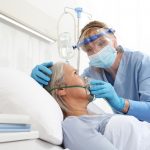MANIPULATION: 40-45 percent of “COVID hospitalizations” had some other reason for admission, new study reveals
 (NaturalHealth365) The main message last year of Big Pharma, news media, and government officials was that getting a COVID shot would help stop the spread of SARS-CoV-2. It was your “duty” as a citizen to do the right thing and help protect others (never mind that there are both known and unknown risks to these mRNA jabs – risks you must assume in full).
(NaturalHealth365) The main message last year of Big Pharma, news media, and government officials was that getting a COVID shot would help stop the spread of SARS-CoV-2. It was your “duty” as a citizen to do the right thing and help protect others (never mind that there are both known and unknown risks to these mRNA jabs – risks you must assume in full).
Lately, officials have changed their tune since data shows fully jabbed people can still catch and spread the so-called pandemic virus. Now, if you end up testing positive for COVID-19 even after your jabs, at least you’re less likely to get seriously ill or be sent to the hospital. While data suggests this is true, a new study reveals that the number of COVID hospitalizations is entirely misleading.
COVID-19 hospital rates exaggerated, breaking study reveals
A new study available for preprint only (yet to be peer-reviewed) revealed some jaw-dropping clarifications about coronavirus hospitalization rates across the country.
The study, called “The COVID-19 Hospitalization Metric in the Pre- and Post-vaccination Eras as a Measure of Pandemic Severity: A Retrospective, Nationwide Cohort Study,” analyzed admissions data of patients in the US Department of Veterans Affairs (VA) healthcare system from March 1, 2020, through June 30, 2021.
Incredibly, the study authors found that only 52% of people admitted with COVID-19 to VA hospitals during this time had a moderate-to-severe disease, whereas 48% had only mild or asymptomatic disease. (The authors defined moderate-to-severe COVID-19 disease as the use of any supplemental oxygen or documented blood oxygen levels of less than <94% among people testing positive for SARS-CoV-2.)
Even before widespread jab availability, nearly 40% of all COVID hospitalizations were classified as mild or asymptomatic. Disease severity, the authors continue, is currently lower for both unvaccinated and vaccinated patients compared to disease severity before the jab rollout.
In other words:
Close to half of all hospitalizations linked with a positive COVID-19 test are essentially due to incidental findings. Given how hospital rates influence public policy measures, patients admitted with (and not from) COVID-19 should not be counted as COVID hospitalizations, says study co-author and infectious disease epidemiologist, Dr. Shira Doron.
With more people in hospitals – and fewer staff members to care for them – is firing healthcare workers really in the best interest of American communities?
Back in late August, over 100,000 people in the United States were hospitalized with COVID-19, according to the U.S. Department of Health and Human Services. In the context of the preprint study we just learned about, it’s important to pay attention to language here: these were people hospitalized with COVID-19, and not necessarily for COVID-19.
Indeed, it’s a tragedy to see anyone hospitalized, but there’s one factor routinely being ignored: hospitals around the country are facing critical staffing shortages – many have been since before the pandemic. The added strain of the pandemic appears to have heightened an issue long facing many of our country’s medical systems.
This genuinely calls into question the push to fire healthcare workers who are choosing not to get the COVID shot right now. After all, if staff shortages are that dire and hospitals that full – and if fully jabbed people can still spread the disease anyway – why not provide reasonable accommodations to anyone who declines the jab so that they can continue working and helping with this crisis?
Evidence, including a 2021 study published in Occupational & Environmental Medicine, does suggest that healthcare workers are considered high risk for COVID-19 and are more likely to get seriously ill than people in other professions. But so far, most of this data is observational (no cause and effect links can be drawn), and the absolute likelihood of healthy people getting seriously ill is still low.
In any case, none of these points supersede the fact that people reserve the right to bodily autonomy and informed consent.
Sources for this article include:
Newsmax.com
Nature.com
TheAtlantic.com
NYmag.com
NPR.org
BMJ.com
Healthdata.gov
Researchsquare.com



